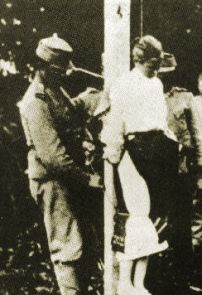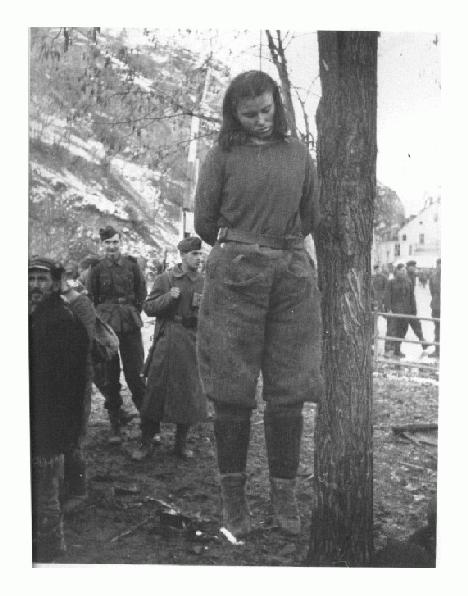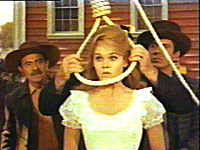
Hanging method used in Austria


Hanging method used in Austria |
Up to 1871 all hangings in Britain used the "short drop" where the prisoner only dropped a few inches and usually died by slow strangulation that could typically take up to fifteen minutes. The more fortunate, died due to Vagal Reflex (pressure on the Vagal nerve) which causes death very quickly. Occasionally the prisoner was later revived even after hanging for half an hour and there are several recorded cases of this where people lived for many years afterwards. |

|

As a result of these incidents a slightly longer drop, of about 12 - 18 inches became normal to ensure that prisoners did not survive, however this extra drop tended to cause them to suffer a more agonizing death as it was not long enough to break the neck but the force of it tore the neck muscles and sometimes the skin. Hanging using a short drop is still used by some Middle Eastern countries notably Iran, Iraq and Libya.
The "Long Drop" method.

In 1871 hangman William Marwood introduced the "long drop" method which
it is thought had been invented by doctors in Ireland. It removed most
of the prisoner's physical suffering and made the whole process far less
traumatic for the officials who now had to witness it in the confines of
the execution cell instead of in the open air. The long drop method was
designed to break the prisoners' neck by allowing them to fall a pre-determined
distance and then be brought up with a sharp jerk by the rope.
 |
At the end of the drop the body is still accelerating under the force
of gravity but the head is constrained by the noose which delivers a massive
blow to the back and one side of the neck which combined with the downward
momentum of the body breaks the neck and ruptures the spinal cord and is
thought to cause instant unconsciousness and rapid death. The drop given
was usually between 4 & 10 feet depending on the weight and strength
of the prisoner. The actual amount being calculated to provide a final
"striking" force of approximately 2240 lbs force (one ton) which combined
with the positioning of the eyelet of the noose normally under the left
angle of the jaw (the submental position) causes fracture and dislocation
of the neck usually at the 2nd and 3rd or 4th and 5th Cervical vertebrae.
In the early days there was a considerable amount of experimentation to determine the exact amount of drop and James Berry, who succeeded Calcraft, had an unfortunate experience when hanging a murderer called Goodale who was decapitated by the force of the drop. |
The Home Office was eventually able to issue executioners with a table
of drops and there were no more decapitations. Berry had another unfortunate
incident when he made three attempts to hang a young man called John Lee
at Exeter due to the failure of the trap doors to open. Hanging continued
in this form up to 1964 with occasional minor refinements designed to speed
it up and make it less of an ordeal for the prisoner and staff. It is reported
that executions, in this century, rarely took more than 15 seconds from
the time the hangman entered the condemned cell to the prisoner being unconscious.
The quickest ever, being carried out in just 8 seconds by Albert Pierrepoint
and Sid Dernley in the 1950's.
Ruth Ellis was the last woman to be
hanged in Britain in the year 1955
Hanging for murder was abolished in December 1969 (High Treason and Piracy remaining capital crimes to the present day, although there have been no executions for either crime since 1947). =
Efforts to have capital punishment abolished had been going on since the 1840's, with some success, e.g. limiting the number of capital crimes and stopping public executions. The public enjoyed these far more than was thought good for them. The Establishment has never been happy about the ordinary people enjoying overtly morbid pastimes such as watching a murderer struggling on the end of a rope or nowadays seeing at the results of a motorway pile up or an air crash and always does its best to prevent us from so doing, - no doubt for our own good.

A hanging in Egypt
Attitudes in Britain had been changed by the Second World War, class
barriers came down and people felt sickened by the holocaust of Nazi Germany.
The Press stimulated public interest in murder trials and the eventual
fate of those convicted and sentenced to death. who became far less de-humanized
as a result. Virtually every word of the more interesting murder trials
used to be reported in the popular press in the Forties and Fifties whereas
now hardly any detail of most trials is actually reported. As the execution
date drew near there would be much speculation as to whether a particular
prisoner would be reprieved or not.
Executions had also become decidedly unpopular with the Governors and
staff of the prisons in which they took place. This is hardly surprising
as they had become a very rare event in most prisons and tended to upset
the normal running of the whole place. By the 1950's and early 60's a new
breed of prison governor had emerged, no longer the retired army officer
who believed in harsh punishment and firm discipline but prison service
professionals who believed in rehabilitation of offenders and found the
supervising of condemned prisoners and their subsequent execution, a great
strain and totally against their beliefs and training. It must have put
great emotional stress on the officers who formed the death watch and had
to stay with the prisoner for the whole of their eight hour shift each
day. No doubt they saw a completely different side of that person to the
one portrayed in the press. How many of us would really like to stand in
a small room just a few feet from a person we had spoken to every day for
the last two or three months and watch them be hanged by the neck until
dead?

